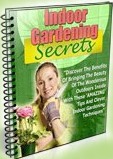Archive for the ‘General Gardening Tips’ Category
 Indoor Organic Gardening
Indoor Organic Gardening
Whether you’re growing plants indoors in your home or you are use a greenhouse for indoor organic gardening, the process is still the same. Organic gardening goes beyond the scope of simply eliminating chemicals and other unnatural substances from the products you use to care for your plants. It’s the entire process of providing healthy food products to your plants and keeping them free of pests, not with chemicals, but by using other “good” pests to eliminate the “bad” pests. It’s similar to the farmer who puts a scarecrow in the garden to repel the crows. It’s a matter of utilizing products that are on hand, and making use of our resources to combat the problems during indoor organic gardening.
When one has an indoor garden, it’s more important that you practice indoor organic gardening than with an outside garden. Perhaps that doesn’t sound politically correct, but in essence, you are putting your own family at risk if you use harsh chemicals on the plants you grow indoors. That doesn’t mean that you shouldn’t care just as much if you’re growing things outdoors, but outdoors, oftentimes the natural elements in the air will eliminate many of the toxins that might otherwise become a part of the plants themselves, but when you grow things indoors, you do not have the potential for that to happen. Thus, it’s more important to practice indoor organic gardening for the safety of your family and those who may enter the building where your plants are housed.
Indoor organic gardening can be a challenging experience on its own because of the confined spaces, especially if you are restricted to a porch or small room rather than a greenhouse, which has more room. You, of course, want to choose plants that you are going to grow contingent upon the space you have available so that they will be able to grow properly, and you can keep them healthy for the duration of the time they must be indoors. For example, unless you have a greenhouse, you are not going to grow lettuce, potatoes, or corn because there isn’t enough room. In fact, one couldn’t even grow corn in a greenhouse, though they may attempt lettuce or potatoes if it’s a big enough building.
The two most important factors with indoor organic gardening is to be certain you have enough space for the plants you wish to grow and be more cognizant of the ingredients in the products you use, choosing elements such as other insects to control insect growth in your plants rather than chemical repellents. If you haven’t planted indoors before, make sure you know exactly what is required before you begin and have all the organic products you need closely.
 NATIONAL HOME GARDENING
NATIONAL HOME GARDENING
National Home Gardening offers many excellent tips for the gardening enthusiast. Do you prefer your own home grown vegetables to the ones you buy at the supermarket? Here are some National Home Gardening tips on how to have a better vegetable garden. First, decide where you are going to have your vegetable garden. For a healthy, fertile garden, you need a spot that will receive at least six hours of sunlight a day. The best soil is a rich, sandy loam. To increase soil nutrients, add compost or manure. Be sure to put compost under and around your plants. National Home Gardening suggests planting your vegetables in a north to south direction so they receive maximum sunlight.
Your vegetable garden should be on level ground. Leave wide spacing between the rows so you will have room to do the weeding and to harvest your vegetables. It is best to use fresh, new seeds. Old seeds might not germinate properly. You can also start your plants indoors early, and then transplant them to your garden.
If you are a first time vegetable gardener, when you go to the garden centre to buy your seeds, talk to the staff there. They will be glad to give you some expert advice. They might suggest planting different crops that complement each other in order to maximize your crop. That will also give you a greater variety of vegetables.
Plant your vegetable garden close to your house. This will make it easier for you to tend your garden. It will also make it easier for you to step out and pick a few fresh vegetables while you are preparing a meal.
National Home Gardening offers tips on how to save water while you are maintaining your lawn and garden. This is especially important in the hot summer months, when there are often water restrictions. Before you do your watering, keep in mind how much rain has fallen in the preceding week. To do this, keep a measuring container in the yard. Be sure to empty it once a week.
Do your watering early in the morning. This will reduce evaporation and scorching by the sun. Also, it is better to water on a calm day rather than a windy day. This, too, will reduce evaporation.
Position your sprinkler to avoid watering the patio and the driveway. That is wasted water. Water slowly. This avoids run-off, and allows the soil to absorb the water. Check your hose and other watering equipment regularly for leaks and blockages. Collect rainwater from your roof in a rain barrel or other large container. Screen the top to keep insects out.
National Home Gardening makes one more suggestion. Remember, it is the ground that needs the water, not the plants’ leaves.
